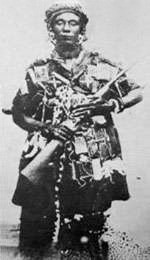
Image: Yaa Asantewaa in batakarikese (ceremonial war dress) in an undated photograph.
In 1901, after leading the Ashanti people in their last major armed resistance against British colonial rule, Yaa Asantewaa was captured and exiled to the Seychelles Islands. She died there in 1921, far from her homeland. Though she did not live to see Ghana’s independence in 1957, her bravery became a lasting symbol of anti-colonial resistance and the enduring spirit of African freedom.
Yaa Asantewaa’s leadership inspired generations of Ghanaians and Africans across the continent. As a queen mother, military commander, and defender of cultural sovereignty, she defied both colonial power and gender expectations. Her stand in defense of the Golden Stool became a defining moment in the Ashanti struggle for dignity and self-rule.
After Ghana gained independence—the first sub-Saharan African nation to do so—her legacy was embraced as part of the national identity. Schools, festivals, and monuments now bear her name.
One of the most notable is the Yaa Asantewaa Girls’ Secondary School in Kumasi, which continues her mission by empowering young women through education.
Today, Yaa Asantewaa is honored not only as a heroine of the Ashanti Kingdom, but as one of Africa’s greatest freedom fighters—a woman whose courage helped light the path toward Ghana’s independence and whose story continues to inspire movements for justice, equality, and self-determination around the world.